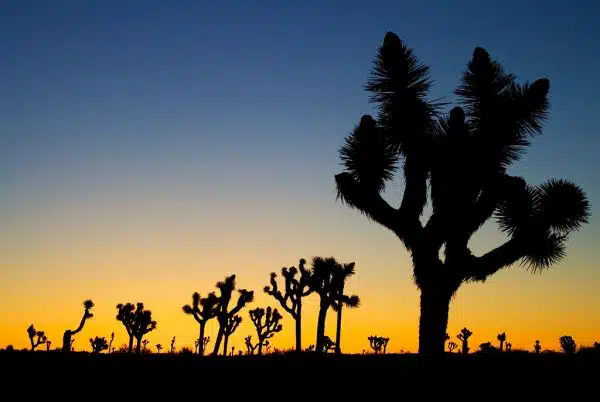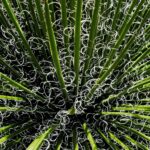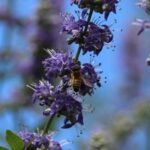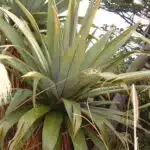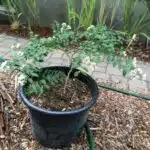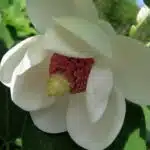Yucca Brevifolia, popularly known as Joshua Tree, is a slow-growing tree with an iconic shape that is native to the Mojave Desert in California. The plant is famous for its rugged and resilient nature, which makes it a valuable addition to any garden or landscape. Understanding how to grow and care for Yucca Brevifolia is crucial for anyone interested in adding this unique plant to their collection.
The Joshua Tree grows up to 40 feet tall and produces long, green leaves that are sword-shaped, with sharp tips. The tree’s branches are twisted and gnarled, giving it an otherworldly appearance. The plant’s flowers bloom in spring and summer, producing clusters of white flowers that are bell-shaped. With proper care, the Joshua Tree can live up to 150 years. This article will provide comprehensive information on how to grow and care for Yucca Brevifolia, ensuring that you can successfully cultivate this iconic desert plant in your garden or landscape.
Overview Of Yucca Brevifolia
Yucca brevifolia, commonly known as the Joshua tree, is a slow-growing evergreen plant that belongs to the Asparagaceae family. This plant species is native to the southwestern United States and can grow up to 40 feet tall. It has a unique appearance with twisted branches and spiky leaves that are greenish-gray in color.
Growing tips for Yucca brevifolia involve planting it in well-draining soil with full sunlight exposure. It is a drought-tolerant plant and requires minimal watering during the growing season. Overwatering can lead to root rot, which can be detrimental to its growth. Fertilizing should be done once or twice a year with a balanced fertilizer.
Interesting facts about Yucca brevifolia include its association with Mormon pioneers who named it after Joshua from the Old Testament due to its outstretched branches resembling his arms holding out towards heaven. The tree also provides habitat for various wildlife species such as birds and insects. Additionally, Indigenous people have used different parts of the Joshua tree for medicinal purposes and making tools.
This plant prefers hot and dry climates and thrives in rocky or sandy soil types. In the next section, we will discuss climate and location requirements in detail to help you create an ideal environment for your Yucca brevifolia plant.
Climate And Location Requirements
Like a sentinel standing guard over a vast expanse of desert, the Joshua tree thrives in its native habitat. This magnificent plant requires ideal conditions to grow and flourish, and it is important to understand its climate and location requirements before attempting to cultivate it.
The Joshua tree is native to the Mojave Desert and prefers hot, dry summers and cool winters. It can tolerate temperatures ranging from 10°F (-12°C) to 120°F (49°C), but it needs well-draining soil and minimal moisture. In areas with high humidity or excessive rainfall, this plant may struggle to survive.
Joshua trees are adaptable to a variety of microclimates within their range, but they thrive in areas where they receive plenty of direct sunlight and have access to good air circulation. Providing adequate space for growth is also crucial since these trees can reach heights of up to 40 feet (12 meters) with a spread of 20 feet (6 meters). Understanding the ideal climate and location requirements will help ensure that your Joshua tree has the best chance for success.
As a horticulturalist, it is my passion to help others cultivate thriving plants in their own environments. By understanding the specific needs of each species, we can create optimal growing conditions that promote healthy growth and longevity. Moving forward in our discussion on how to grow and care for Yucca brevifolia or Joshua tree, our next topic will focus on soil type and pH preferences – two key factors that play a critical role in ensuring your plant’s success.
Soil Type And Ph Preferences
Yucca brevifolia or Joshua tree thrives in well-draining soil. Soil preparation is crucial for the growth and survival of this plant species. Before planting, remove any debris or rocks that may hinder root development. Incorporate organic matter such as compost or well-rotted manure into the soil to improve its structure and fertility.
Yucca brevifolia prefers a slightly acidic to neutral soil pH ranging from 6.0 to 7.5. An optimal pH range ensures proper nutrient uptake by the roots and prevents toxicity due to an excess of certain elements like aluminum, manganese, iron, and zinc. To determine the pH level of the soil, perform a pH test using a kit available at most garden centers or laboratories.
To adjust the pH level if necessary, add amendments such as sulfur, peat moss, or lime depending on whether you need to make it more acidic or alkaline. However, take caution not to overdo it as excessive amounts of these amendments may have negative effects on plant growth and health. It is advisable to follow recommended application rates based on soil type and test results.
Maintaining proper soil type and pH level are crucial factors in caring for Yucca brevifolia successfully. Investing time in preparing your soil before planting can save you headaches down the road while ensuring healthy growth for your Joshua tree! In addition to these factors, watering needs and frequency are equally important in caring for Yucca brevifolia effectively.
Watering Needs And Frequency
Yucca brevifolia, commonly known as a Joshua tree, is a hardy, drought-tolerant species that requires little water to survive. When grown in a garden, water requirements vary depending on the climate and soil conditions. Generally, the Joshua tree should be watered once a month during the summer months and every other month during the winter months. Frequency of watering should be adjusted depending on the weather conditions and the soil type, taking into account the amount of rainfall the tree receives.
Water Requirements
The watering needs of the Yucca brevifolia or Joshua Tree can be tricky to determine. These plants are highly adapted to desert conditions and have exceptional drought tolerance. However, that doesn’t mean they don’t need water at all. Knowing how often and how much water to give your Joshua Tree is essential for its growth and survival.
The frequency of watering will depend on several factors such as soil type, temperature, humidity, and exposure to sunlight. In general, it’s best to water your Joshua Tree deeply and infrequently rather than giving it small amounts of water frequently. During the summer months, when temperatures are high, you may need to water your plant every 2-3 weeks. During cooler months or if rainfall occurs regularly, you can reduce watering frequency.
It’s important not to overwater your Joshua Tree as this can lead to root rot and other diseases. Allow the soil to dry out completely between each watering session. Also, avoid watering during periods of high humidity or when the plant is in shade as this can promote fungal growth. With proper care and attention to its watering requirements, your Yucca brevifolia will thrive for years to come!
Frequency Of Watering
Watering your plants is a crucial aspect of plant care, and it can be especially tricky for desert-adapted plants like the Yucca brevifolia or Joshua Tree. These plants have exceptional tolerance to drought, but that doesn’t mean they don’t need water at all. Knowing how often and how much water to give your Joshua Tree is essential for its growth and survival.
When it comes to the frequency of watering, there are several factors to consider. Soil type, temperature, humidity, and exposure to sunlight all play a role in determining how often you should water your Joshua Tree. In general, it’s best to water deeply and infrequently rather than giving small amounts of water frequently. During the summer months when temperatures are high, you may need to water your plant every 2-3 weeks. However, during cooler months or if rainfall occurs regularly, you can reduce watering frequency.
Watering techniques are also important when caring for your Joshua Tree. It’s crucial not to overwater as this can lead to root rot and other diseases. Allow the soil to dry out completely between each watering session before giving more water. Deep watering encourages deep root growth while shallow watering can lead to surface roots that are susceptible to drying out quickly. With proper attention paid to both the frequency and technique of watering your Yucca brevifolia will thrive for years to come!
Fertilization Tips And Recommendations
Fertilizers play a crucial role in the growth and health of yucca brevifolia or Joshua tree. It is essential to understand the differences between organic and synthetic fertilizers before deciding which one to use. Organic fertilizers are made from natural sources, while synthetic fertilizers are artificially manufactured. Both types have their benefits and drawbacks.
Organic fertilizers release nutrients slowly over time, providing long-term benefits to the plant. They also improve soil quality by adding organic matter, increasing its water-holding capacity and promoting beneficial microorganisms’ growth. On the other hand, synthetic fertilizers provide quick results but can lead to nutrient imbalances in the soil if not used correctly. It is crucial to follow application instructions carefully and avoid over-fertilizing, as it can burn roots and harm the plant.
Table: Fertilizer Application Frequency
| Fertilizer Type | Frequency |
|---|---|
| Organic | Once a month during growing season |
| Synthetic | Every two weeks during growing season |
To ensure optimal growth and health of Joshua trees, it is recommended to fertilize them regularly during their growing season. For organic fertilizers, apply once a month, while for synthetic ones, apply every two weeks. It is advisable to use a balanced fertilizer with equal amounts of nitrogen, phosphorus, and potassium (NPK). However, it would be best to conduct a soil test before applying any fertilizer to determine which nutrients are lacking or abundant.
Incorporating proper fertilizer application into your care routine will significantly benefit your Joshua tree’s growth and overall health. However, remember that fertilizer should not be the sole source of nutrients for your plant; they still require adequate sunlight exposure and regular watering. In our next section, we will discuss pruning and maintenance techniques that will keep your Joshua tree healthy and thriving for years to come without harming it accidentally by using improper techniques.
Pruning And Maintenance Techniques
After fertilizing your yucca brevifolia, it is crucial to prune and maintain it properly. Pruning techniques play a significant role in maintaining the health and shape of your joshua tree. Start by removing dead or damaged leaves with sharp pruning shears. Trim back any branches that are crossing each other or growing in the wrong direction. Proper pruning will not only help to shape your tree but also promote new growth.
Maintenance strategies are essential for keeping your yucca brevifolia healthy and vibrant. Regular watering is necessary during the first year after planting to establish roots, but once established, they can tolerate drought conditions. Mulching around the base of the tree can help retain moisture in the soil while preventing weed growth. Additionally, monitor your plant for pests like spider mites or mealybugs that can harm its growth.
To ensure optimal growth and health of your joshua tree, follow these three maintenance strategies:
- Remove weeds around the base of your plant to prevent them from competing for resources.
- Water deeply and infrequently to encourage deep root growth.
- Monitor for pests regularly and take action as soon as you notice any infestations.
By implementing these maintenance techniques into your routine, you can enjoy a healthy and thriving yucca brevifolia for years to come. In the next section, we will explore propagation methods so that you can expand your collection or share this unique plant with others.
Propagation Methods
Coincidentally, the Joshua tree’s ability to propagate is also a symbol of its resilience. The yucca brevifolia can be propagated through three main techniques: seed, cutting, and division. Seed propagation involves planting seeds during early spring in well-draining soil, while cutting propagation requires taking a stem cutting from the parent plant and rooting it in moist soil. Division propagation, on the other hand, involves digging up the parent plant and separating its offsets or pups.
Regardless of the propagation technique used, proper nursery care is essential for successful growth. After planting or potting, keep the soil consistently moist but not waterlogged to avoid root rot. Place the newly propagated plant in a bright location with indirect sunlight to ensure healthy growth. Proper fertilization can also support healthy growth; feed your propagated Joshua tree with half-strength fertilizer every two weeks during the growing season.
In summary, mastering propagation techniques and providing adequate nursery care are important for ensuring successful Joshua tree cultivation. By following these guidelines, you can create new generations of resilient yucca brevifolia plants that will continue to thrive for years to come. In the next section, we will discuss how to protect your Joshua tree from common pests and diseases that may threaten its health and longevity.
Pest And Disease Management
- Proper identification of the pests and diseases affecting Yucca Brevifolia (Joshua Tree) is key in order to take the appropriate course of action for control.
- Cultural practices such as proper soil drainage, adequate sunlight, and periodic pruning can help to prevent and control pests and diseases.
- Chemical control of pests and diseases is often necessary and can be accomplished through the application of appropriate insecticides and fungicides.
- Biological control through the use of beneficial organisms can also be used to help manage pests and diseases on Yucca Brevifolia (Joshua Tree).
Identifying Pests And Diseases
Yucca brevifolia, commonly known as the Joshua tree, is a stunning and unique plant that requires proper care to maintain its beauty. Identifying pests and diseases is crucial for pest and disease management. Preventing infestations can save you time, money, and effort in the long run. It’s essential to inspect your Joshua tree regularly for any signs of pests or diseases.
Joshua trees are susceptible to a variety of pests, including spider mites and mealybugs. Spider mites are tiny insects that feed on the sap of the leaves, causing yellowing and browning. Mealybugs are soft-bodied insects covered with white wax that can cause stunted growth and leaf drop. To prevent infestations, it’s important to keep your Joshua tree healthy by providing adequate water and nutrients.
Fungal infections can also affect your Joshua tree, causing leaf spots, stem rot, or root rot. These infections thrive in moist conditions, so it’s crucial to avoid overwatering your plant. Treating fungal infections involves removing infected parts of the plant and applying a fungicide to prevent further spread. With proper care and regular inspection for pests and diseases, you can ensure your Joshua tree thrives for years to come without any issues.
Controlling Pests And Diseases
Pest and disease management is an essential aspect of maintaining the beauty and health of a Joshua tree. It’s important to identify any signs of pests or diseases early on to prevent infestations, which can save time, money, and effort in the long run. Preventive measures such as regular inspection, adequate watering, and providing proper nutrients are crucial for keeping your Joshua tree healthy.
Controlling pests and diseases involves using various methods such as natural remedies or chemical treatments. For example, neem oil is a natural insecticide that is effective in controlling spider mites and mealybugs. Horticultural oils can also be used to smother insects and their eggs. In severe cases, chemical treatments may be necessary, but it’s important to use them responsibly by following instructions carefully.
Preventing fungal infections involves avoiding overwatering your Joshua tree and providing proper drainage. If an infection occurs, removing infected parts of the plant is essential to prevent further spread. Applying a fungicide can also be helpful in controlling fungal infections. By taking preventive measures and using appropriate treatments when necessary, you can effectively control pests and diseases in your Joshua tree while ensuring its longevity and beauty.
Common Varieties Of Yucca Brevifolia
Yucca brevifolia is a unique and renowned plant species that belongs to the agave family. There are several Yucca brevifolia varieties, but the most common one is the Joshua Tree. This tree is native to the southwestern United States and can grow up to 40 feet tall. The Joshua Tree has a distinct appearance with its spiky leaves and twisted branches.
The Joshua Tree has several characteristics that distinguish it from other Yucca brevifolia varieties. Its leaves are blue-green in color, and they grow densely around the branches. The tree also produces white flowers that bloom in the springtime, attracting pollinators such as moths and bees. Another notable characteristic of the Joshua Tree is its bark, which has a rough texture that enables it to withstand harsh desert conditions.
Apart from Joshua Trees, there are other Yucca brevifolia types that are less known but equally fascinating. These include the Panamint or Rockland Mountains variety, which grows at higher elevations than the Joshua Tree, and has blue-green leaves with less dense foliage. The Mojave yucca variety also differs from the Joshua Tree in leaf shape and flower size. However, all Yucca brevifolia varieties share some similar features such as adaptability to arid environments, low maintenance requirements, and appealing ornamental value.
When selecting a Yucca brevifolia variety for your landscape design project, consider their unique characteristics and growth requirements. Choose a location that receives adequate sunlight exposure and well-draining soil for optimal growth performance. Incorporating different Yucca brevifolia types in your landscape design creates an exciting contrast that enhances visual interest while simultaneously adding value to your property’s curb appeal.
Landscaping And Design Ideas
One interesting statistic about landscaping is that it can increase property value by up to 20%. Adding unique and visually appealing elements to your yard, such as yucca brevifolia or Joshua trees, can make a significant impact on the overall aesthetic of your outdoor space.
When designing your landscape, consider incorporating outdoor lighting to highlight the beauty of your yucca brevifolia. This type of lighting not only adds an element of safety and security to your home but also creates a warm and inviting ambiance. Additionally, rock and boulder arrangements around the base of the Joshua trees can enhance their natural desert environment while creating a visually striking contrast.
Incorporating yucca brevifolia into your landscape design requires careful consideration and attention. However, with proper care and maintenance, these trees can thrive in any climate. Below are frequently asked questions about growing yucca brevifolia that will help you create a beautiful and sustainable landscape for years to come.
Frequently Asked Questions About Growing Yucca Brevifolia
The optimal soil for yucca brevifolia growth is sandy soil, with a combination of clay, loam and sand, which will help to maintain an appropriate pH balance. When first planted, yucca brevifolia should be watered deeply, but then only needs supplemental irrigation during periods of drought. Over-watering can cause root rot and other issues, so water should be applied sparingly. Yucca brevifolia is a desert plant, so it is important to be mindful of the amount of water used to ensure its health and flourishing growth.
Which Soil Is Best For Yucca Brevifolia
When it comes to growing Yucca Brevifolia or Joshua Tree, selecting the right soil is crucial. These plants are known for their hardiness and ability to thrive in harsh environments, but they still require specific soil conditions to grow successfully. The best soil for Yucca Brevifolia is one that is well-draining and has excellent aeration. Sandy soils with a pH range of 6.0-7.5 work exceptionally well.
One way to ensure that your Yucca Brevifolia has the perfect soil environment is by using potting mix options specifically designed for desert plants. These mixes typically contain sand, perlite, peat moss, and other materials that improve drainage and aeration while retaining moisture. While commercial potting mixes can be costly, they are worth the investment as they provide optimal growing conditions for your Joshua Tree.
In addition to choosing the right soil mix, providing regular fertilization will help your Yucca Brevifolia reach its full potential. Best fertilizers include slow-release granules containing nitrogen, phosphorus, and potassium or organic options such as bone meal or worm castings. Fertilize your plant once every three months during the active growing season (spring through summer) for best results. With proper care and attention to its soil needs, your Yucca Brevifolia will flourish into a stunning desert beauty.
How Much Water Does Yucca Brevifolia Need
As a horticulturalist, one of the most common questions I receive about growing Yucca Brevifolia is regarding watering frequency. These desert plants are known for their ability to survive in harsh conditions with minimal water, but how much water do they really need?
The answer depends on several factors such as the plant’s age, size, and soil conditions. In general, it’s best to water your Yucca Brevifolia deeply once every two to three weeks during the growing season (spring through summer) and reduce watering frequency during the dormant season (fall through winter). However, it’s important to always check the soil moisture level before watering as overwatering can be detrimental to these plants.
Signs of overwatering include yellowing leaves, soft or mushy stems, and a foul smell emanating from the soil. If you notice any of these signs, reduce watering frequency and allow the soil to dry out before watering again. Remember that Yucca Brevifolia is adapted to survive in arid environments and can withstand periods of drought. With proper care and attention to its watering needs, your Joshua Tree will thrive into a stunning addition to your landscape.
How To Transplant A Joshua Tree
After learning about the frequently asked questions on growing Yucca Brevifolia, it’s time to focus on transplanting the plant. Transplanting a Joshua tree is essential if it outgrows its pot or if you want to grow it in your garden. However, before transplanting, choosing the right pot is crucial. The pot should be large enough to accommodate the roots and provide sufficient drainage holes.
Maintenance after transplanting is an important aspect of ensuring the survival of your Joshua tree. After transplanting, water the plant deeply and give it some time to adjust to its new environment. Avoid overwatering as this may cause root rot. It’s also advisable to add some mulch around the base of the tree to retain moisture and prevent weed growth.
Now that you know how to choose the right pot and maintain your Joshua tree after transplanting, let’s discuss the best time for planting a Yucca Brevifolia. The ideal time for planting is during spring or fall when temperatures are cooler. This allows for better root establishment before summer heat or winter frost arrives. When planting, ensure that you position the plant in full sun and well-draining soil for optimal growth.
Best Time To Plant A Yucca Brevifolia
The best time to plant a Yucca brevifolia, also known as the Joshua tree, is during the spring or fall season. Springtime planting is ideal because of the favorable soil temperatures that range between 60°F to 70°F. This temperature range promotes better root growth and provides an optimal environment for your Yucca brevifolia to establish itself. Planting in fall is also a great option as it allows the plant enough time to develop its roots before winter sets in.
To ensure successful growth during each season, it’s important to prepare the soil properly beforehand. The ideal soil should have good drainage and a pH level ranging from 6.0 to 7.5. If you’re planting in spring, make sure that soil temperatures are consistently above freezing point before planting your Yucca brevifolia. If you plan on planting in fall, do so at least six weeks before temperatures start dropping below freezing point.
During both seasons, it’s essential to water your newly planted Yucca brevifolia regularly but not excessively. Overwatering can lead to root rot and stunted growth while under-watering can cause wilting and yellowing of leaves. In addition, applying organic mulch around the base of your plant helps retain moisture and regulate soil temperature.
In summary, choosing the best time to plant a Yucca brevifolia will largely depend on your location and climate conditions. Ensure that you prepare your soil adequately beforehand, water your plants appropriately and apply organic mulch around the base of your plant for optimal growth results in each season. Next up we’ll discuss tips for growing Yucca brevifolia in containers without sacrificing their health and well-being.
Tips For Growing Yucca Brevifolia In Containers
When choosing a container for growing Yucca Brevifolia, it is important to select one that is deep, as the plant’s long taproot requires a lot of room for growth. Planting should be done in well-draining soil and can be done at any time of year. Yucca Brevifolia should be watered deeply once a week, allowing the top two inches of soil to dry out between waterings. During hot and dry weather, more frequent watering may be necessary. Fertilizing should be done once a month during the active growing season using a balanced fertilizer. Over-fertilizing can cause damage to the foliage, so it is important to use the fertilizer sparingly.
Choosing A Container
When growing Yucca Brevifolia in containers, choosing the right container size is crucial. The size of the container should be big enough to allow for proper root growth and development. A smaller container may cause the roots to become crowded, leading to stunted growth and ultimately death. On the other hand, a container that is too large may cause overwatering, which can also be detrimental to your Yucca Brevifolia. It’s recommended that you choose a container that is at least 2-3 inches larger in diameter than the root ball of your plant.
In addition to size, material options are also important when choosing a container for Yucca Brevifolia. Clay or terracotta pots are a popular choice as they are porous and allow for adequate drainage while also being heavy enough to support the weight of the plant as it grows. However, clay pots can dry out more quickly than other materials and may require more frequent watering. Plastic containers are lightweight and easy to move around but may not provide adequate drainage if not properly drilled with holes at the bottom.
Overall, selecting the right container for your Yucca Brevifolia is essential for its long-term health and growth. Consider both size and material options before making your decision. Remember that larger isn’t always better, and drainage is key for ensuring healthy roots. By following these tips, you’ll be on your way to successfully growing this stunning desert plant in containers!
Planting And Watering
To successfully grow Yucca Brevifolia in containers, it’s essential to consider not only the container size and material but also the planting depth and sunlight exposure. When planting your Yucca Brevifolia, ensure that the top of the root ball is level with the soil surface. Planting too deep can cause root rot, while planting too shallow can lead to dehydration. Additionally, ensure that your plant receives adequate sunlight exposure, as Yucca Brevifolia requires full sun to thrive.
When watering your Yucca Brevifolia in containers, it’s crucial to strike a balance between overwatering and underwatering. Overwatering can lead to root rot and other diseases, while underwatering can cause dehydration and wilting. To avoid these issues, water your plant deeply once a week during the growing season and reduce watering frequency during the winter months. Ensure that excess water drains out of the container by choosing a pot with adequate drainage holes.
Finally, it’s important to note that Yucca Brevifolia is a slow-growing plant that requires minimal maintenance once established. However, periodic pruning may be necessary to remove dead or damaged leaves and maintain its shape. With proper planting depth, sunlight exposure, and watering practices, you can enjoy this stunning desert plant in your container garden for years to come!
Fertilization
Fertilization is an essential aspect of growing Yucca Brevifolia in containers. Proper fertilizer application can help ensure that your plant receives the necessary nutrients it needs to thrive. However, it’s important to note that overfertilizing can lead to nutrient deficiencies and other problems, so it’s crucial to strike a balance.
To fertilize your Yucca Brevifolia, use a balanced fertilizer with equal amounts of nitrogen, phosphorus, and potassium. Apply the fertilizer once every four weeks during the growing season, starting in early spring and continuing through late summer. Avoid fertilizing during the winter months when growth slows down.
Keep in mind that Yucca Brevifolia is a hardy plant that can tolerate nutrient-poor soil. However, if you notice signs of nutrient deficiencies such as yellowing leaves or stunted growth, consider increasing your fertilizer application or switching to a specialized fertilizer designed for succulent plants. With proper fertilization practices, you can help ensure that your Yucca Brevifolia grows healthy and strong in its container.
Harvesting And Using The Plant’s Parts
The Joshua Tree, also known as Yucca brevifolia, is a tall and iconic plant that can grow up to 60 feet. It is native to the Mojave Desert in the southwestern United States, particularly in California, Nevada, Utah, and Arizona. Interestingly, research shows that the Joshua Tree’s lifespan ranges from 150 to 200 years old. This fact highlights the importance of proper care and maintenance of this plant species.
Harvesting Techniques for Yucca brevifolia can vary depending on what part of the plant you want to use. The leaves are often used in basket weaving or for making rope due to their long and sturdy fibers. Before harvesting, it is essential to ensure that only mature leaves are harvested without damaging the plant’s growing tip. The flowers and fruit of this plant are also edible and have been traditionally used by indigenous people as a food source.
The Joshua Tree has been an important part of traditional medicine for centuries. Its roots have been used for treating a range of illnesses such as coughs, colds, and arthritis pain. Additionally, various parts of the plant have been utilized for their antiseptic properties in wound healing. However, it is essential to note that harvesting these plants should be done with caution to avoid overharvesting or damaging the ecosystem where they grow naturally. With proper management practices and responsible harvesting techniques, we can continue using Yucca brevifolia sustainably for generations to come.
Conclusion
Yucca brevifolia, commonly known as the Joshua Tree, is a remarkable plant with exceptional features. As a horticulturist, it is imperative to understand the climatic and soil requirements of this plant to guarantee its proper growth and development. The Joshua Tree thrives in arid regions with temperatures ranging from 50°F-80°F. It prefers rocky or sandy soils with pH levels ranging between 6-7.5.
Watering is crucial for the Joshua Tree’s survival, especially during the first year after planting. Water it deeply once every two weeks until established, then reduce watering frequency to once every month or so. Adding organic matter to the soil can improve water retention and nutrient uptake.
Fertilization should be done sparingly, preferably in early spring or late fall when the plant is dormant. A light application of a balanced fertilizer will suffice for optimal growth. Transplanting should be done carefully since Yucca Brevifolia has a sensitive root system that can easily get damaged.
In conclusion, growing and caring for Yucca Brevifolia requires an understanding of its unique needs and preferences. Whether planting it in the ground or in containers, providing adequate sunlight exposure and well-draining soil is essential for its survival. With proper care and attention, this resilient plant can grow up to 40 feet tall and live up to hundreds of years! So let’s embrace this anachronism of nature and cultivate it for generations to come!
Image Credits
- “Joshua Tree – Yucca brevifolia” by Gregory ‘Slobirdr’ Smith (featured)

